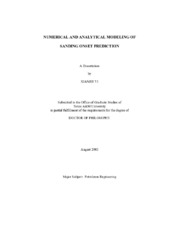| dc.description.abstract | To provide technical support for sand control decision-making, it is necessary to predict the production condition at which sand production occurs. Sanding onset prediction involves simulating the stress state on the surface of an oil/gas producing cavity (e.g. borehole, perforation tunnel) and applying appropriate sand production criterion to predict the fluid pressure or pressure gradient at which sand production occurs. In this work, we present numerical and analytical poroelastoplastic stress models describing stress around producing cavity and verify those models against each other. Using those models, we evaluate the stress state on the cavity surface and derive sanding onset prediction models in terms of fluid pressure or pressure gradient based on the given sand production criterion. We then run field case studies and validate the sanding onset prediction models.
Rock strength criterion plays important roles in sanding onset prediction. We investigate how the sanding onset prediction results vary with the selection of one or another rock strength criterion. In this work, we present four commonly used rock strength criteria in sanding onset prediction and wellbore stability studies: Mohr-Coulomb, Hoek-Brown, Drucker-Prager, and Modified Lade criteria. In each of the criterion, there are two or more parameters involved. In the literature, a two-step procedure is applied to determine the parameters in the rock strength criterion. First, the Mohr-Coulomb parameters like cohesion So and internal friction angle ff are regressed from the laboratory test data. Then, the parameters in other criteria are calculated using the regressed Mohr-Coulomb parameters. We propose that the best way to evaluate the parameters in a specific rock strength criterion is to perform direct regression of the laboratory test data using that criterion. Using this methodology, we demonstrate that the effect of various rock strength criteria on sanding onset prediction is less dramatic than using the commonly used method. With this methodology, the uncertainties of the effect of rock strength criterion on sanding onset prediction are also reduced. | en |


